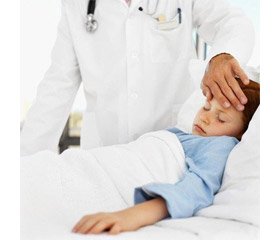Журнал «Актуальная инфектология» 1 (6) 2015
Вернуться к номеру
Peculiarities of norovirus and adenovirus infections in children
Авторы: L. Palatna - Department of Paediatric Infectious Diseases Bogomolets National Medical University, Kyiv, Ukraine; A. Vilensky, N. Pranik, S. Renchkovska - Medical Network "DOBROBUT", Kyiv, Ukraine
Рубрики: Инфекционные заболевания
Разделы: Клинические исследования
Версия для печати
Introduction. Nowadays the frequency of noroviruses types 1 and 2 and adenoviruses serotypes 40-41 as causes of gastrointestinal disorders is increasing [1, 4, 9, 11]. In literature this trend is associated with the appearance of rotavirus vaccine [2, 10]. Taking into account a low vaccination against rotavirus, the relevance of our research is justified by the fact that in Ukraine there are no data on the prevalence and features of norovirus and intestinal forms of adenovirus infection in children.
Materials and methods. The study involved 24 children with gastrointestinal disorders caused by norovirus (11 patients), adenovirus (9 patients) and both agents (4 patients), who were hospitalized in non-epidemic period for these infections (April-November 2014). The presence of genetic material of Shigella spp., enteroinvasive E.coli, Salmonella spp., Campilobacter spp., Adenovirus F, Rotavirus A, Norovirus types 1 and 2 and Astrovirus was studied by using the PCR diagnostic.
Results and discussion. Norovirus infection in the study group patients was recorded mainly in the summer months - 63.6% of cases (of which more than half of the episodes of the disease was observed in August), in autumn - 27.3%, in spring - 9.1%. Adenoviral infection was recorded significantly more in autumn - 77.8% (P <0.005), that was also noted by other authors [8].
Patients with norovirus infection were admitted in inpatient department significantly faster compared with patients with adenovirus (90.9% of patients were hospitalized in the first 6-12 hours of disease, P <0.005), which was associated with hyperthermia (r = 0,963; P <0.001) and vomiting intensity (r = 0,948; P <0.001).
In 81.8% (9) children with norovirus infection ran a fever, of which pyretic and hyperpyretic fever was observed in 22.2% (2) children (maximum temperature rise to 40C), febrile fever - 44.5% (4) subfebril - 33.3% (3) patients. The duration of febrile period in all groups of patients ranged from 12 hours to 3.5 days (25 ± 4,3 hours). Fever in children with adenoviral infection were observed only in 33.3% (3) cases (P <0.001).
In most cases (75-100%) viral infection ran as gastroenteritis, which is confirmed in other studies [6, 11], only 2 children observed enteritis. In patients with norovirus and noroadenovirus infections vomiting was observed significantly more frequently (up to 9 times a day, P <0.05 for norovirus infection, P <0.005 for noroadenovirus infection), intense (P <0.05 for norovirus infection) and a shorter period of time compared to patients with adenoviral gastroenteritis. Vomiting in children with norovirus gastroenteritis was observed mainly in the prehospital phase. In patients with adenovirus gastroenteritis recurrent episodes of vomiting were observed in 62.5% (5) patients. 90.9% (10) children with norovirus infection had watery stool consistency. Adenoviral infection in the majority of patients had mushy stool appearance - 66.7% (6) cases and only 33.3% (3) patients showed watery diarrhea that reliably distinguishes these two comparable groups of patients (p <0,05).
In most cases, the stool was infrequent, 3-6 times per day (maximum of 10 times in case of norovirus infection), brown, yellow or yellow-green color with sour, sometimes fetid smell, and impurities of mucus in ? cases. Duration of intestinal syndrome in most cases did not exceed 2 days. For most children the disease was accompanied by the development of mild or moderate dehydration, confirmed by other authors [12, 13].
Almost half of the children revealed leukocytosis and/or leukocyte formula shift to the left with the normalization of blood formula during the first day of treatment. A slight increase of CRP observed in 20.8% (5) children within 12-48 mg/L (reference value <6.0) only in patients with norovirus infection (P <0.05 comparatively with adenovirus infected patients). In coprogram 50% (12) patients revealed a shift towards the acidic pH. Pancreatic insufficiency syndrome was detected in 20.8% (5) patients, enteric syndrome in 16.7% (4) cases. 41.6% (10) patients ran a significant rises of ketones in urine (7,5-15,0 mmol/l) eliminated within 12-36 hours of treatment in hospital.
In bacteriological study of feces in 25% (6) cases the following pathogenic microorganisms were recorded: staphylococcus aureus * 3-10 * 10 4 - 3 children, klebsiella pneumoniae 10 * 5 + staphylococcus aureus * 10 5 -1, proteus vulgaris 10 * 5 - 1, enterobacter cloacae 10 * 5 - 1.
The length of hospitalization was 1-4 days, it was longer in patients with norovirus infection due to the duration of febrile period (r = 0,717; P <0.05) and intestinal disorders (r = 0,640; P <0.05), which is observed by other authors [6] .
Conclusions. Etiological diagnosis of gastroenteritis in children should be used without a break for the summer-autumn period in order to avoid unjustified antibiotic therapy.

